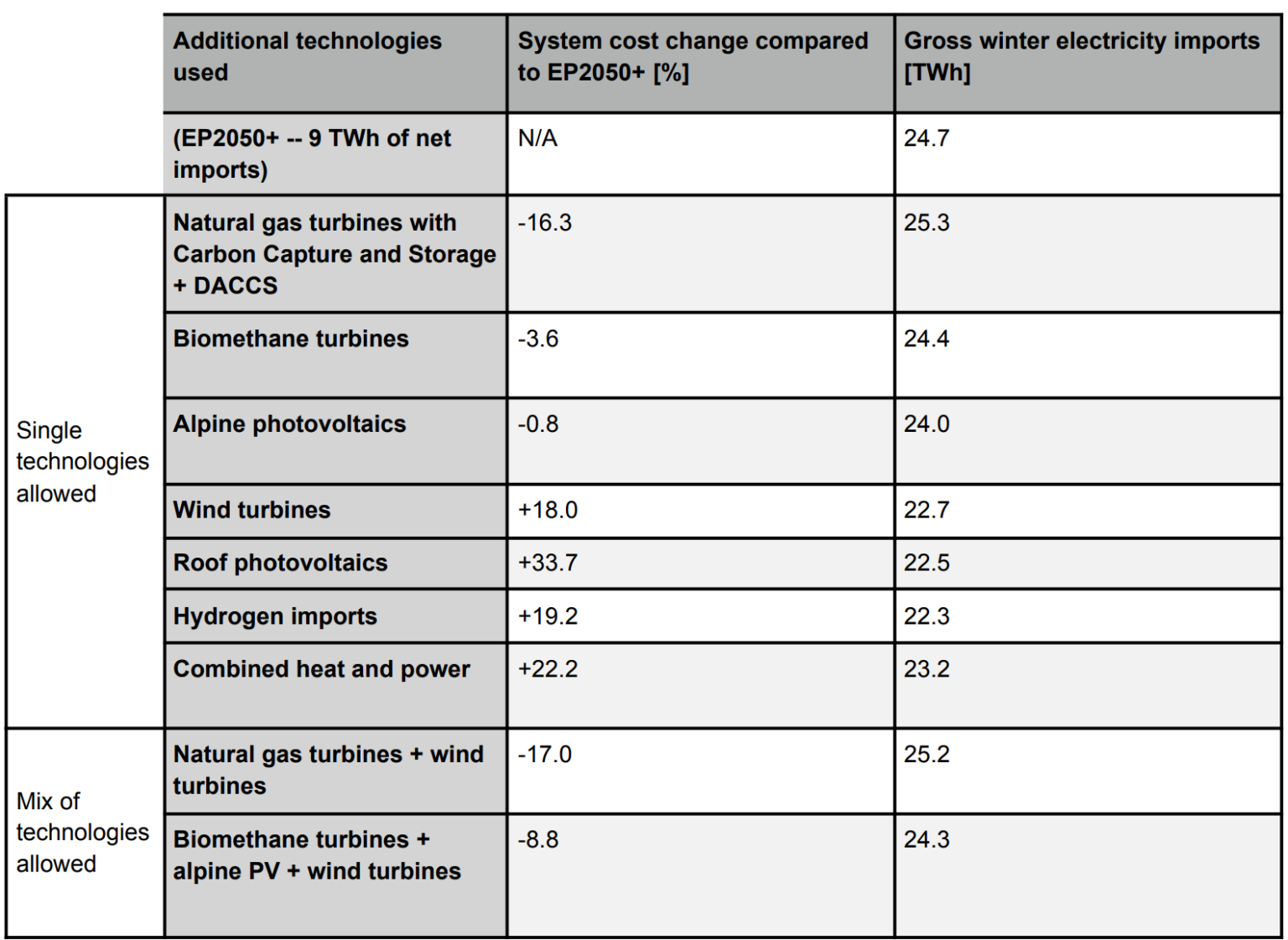
Bridging the gap: How Switzerland can reinforce its winter electricity supply
On 20.06.2024 by Adrien MellotBy Adrien Mellot
Adrien Mellot is a PhD candidate at the Climate Policy Lab of ETH Zurich. His research interests revolve around the design of decarbonised and sector-coupled energy systems, focusing on the role of energy policies to integrate newly electrified loads into the power system.
Electricity autarky is a sensitive topic in Swiss politics, with electricity supply in winter often being the centre of attention. The bill on a secure electricity supply, voted on June 9, 2024, introduced a new provision aiming to limit net winter electricity imports to current levels as Switzerland transitions. In a recent study, we delved into how to align the current Swiss transition roadmap with this new policy goal.
Electricity autarky is a contentious topic in Swiss politics and society. Supply in winter is particularly critical in this regard, as Switzerland traditionally becomes a net importer of electricity during the wintertime. This phenomenon has been coined as the winter gap, and is expected to persist and even grow with the ongoing energy transition. In fact, the bill on a secure electricity supply, voted on June 9, 2024, specifically targets the winter electricity production and the country’s reliance on imports, and includes a target of maximum net electricity imports in winter of 5 TWh, thereby trying to limit Switzerland’s winter gap to today’s levels.
Our recent study investigated the solutions to the winter gap, with two main findings. Firstly, Switzerland can maintain its winter gap at current levels in a net-zero system, but doing so requires overcoming social acceptance barriers to alpine solar, wind energy and/or gas turbines. For example, wind energy has a 60% national acceptance rate (Figure 1) but still faces high local opposition, as does alpine solar. Secondly, addressing the winter gap should not be viewed as a means to isolate Switzerland from its European neighbours: electricity trade remains crucial for the power system, even with a reinforced winter electricity supply.

Figure 1: Results from the 2022 SWEET EDGE survey.
Switzerland’s winter gap explained
Switzerland’s winter gap is the result of a limited electricity production potential in winter coupled with significant overcapacity in summer. Today, this is mainly due to Switzerland’s abundant hydropower resources, as the seasonal fluctuations of water inflows from snowmelt limit the production of hydropower in winter. Water reservoirs fill up during late spring and summer, reaching their maximum capacity in the fall, before being emptied through the winter. Even with this seasonal storage strategy, the reservoirs’ limited capacity and water inflow patterns imply that dams cannot produce more than 30–50% of Switzerland’s winter electricity, the rest currently being supplied by nuclear energy and imports. Simultaneously, electricity demand in winter tends to be higher, mainly due to space heating demand. In contrast, lower demand in summer implies excess electricity at this time. As such, Switzerland is currently a net importer of electricity in winter, and a net exporter in summer, of roughly 5 TWh in both directions.
With solar energy playing a major role in the future energy system of Switzerland, the seasonality of Swiss electricity production is set to increase as the energy transition unfolds. Beyond its daily fluctuations, solar energy has a seasonal pattern similar to that of water inflows, with limited production in winter and peak production in summer. While strategically-placed solar photovoltaics in alpine terrain can mitigate this thanks to increased winter production, the current energy transition roadmap of Switzerland (EP2050+) does not include such installations, and the Solar Offensive subsidies for this technology only amount to 2 TWh of annual production. Furthermore, the nuclear phase-out and the small planned share of wind energy, which has a seasonal pattern opposite to that of solar, will only exacerbate the seasonality of supply. In parallel, demand from heat pumps and electric vehicles will require higher electricity production overall and particularly in winter (Figure 2). Accordingly, Switzerland is on trend to see its winter gap double, reaching 9—10 TWh in 2050 under its current transition plans.

Figure 2: Evolution of Switzerland’s winter gap under the current EP2050+ roadmap.
Potential solutions to the winter gap
There are essentially three ways of reducing Switzerland’s winter deficit: i) producing more electricity in winter; ii) consuming less electricity in winter, and iii) storing the summer overproduction for the winter months. The modelling of our study, utilising the Calliope framework to represent all energy supply and demand sectors in Switzerland’s future energy system, allows us to capture all three possibilities and their interactions.
We base our study on the EP2050+ reference energy system, and model scenarios with additional capacities of wind energy, thermal power plants (different forms of gas power plants and combined heat and power plants), and photovoltaics (rooftop and alpine), along with imports of hydrogen and synthetic fuels (diesel and methane). We also model short and long term electricity storage in the form of batteries, pumped hydropower, hydro dams, and seasonal hydrogen storage. Finally, all energy systems that we model must be net zero in 2050 and have less than 5 TWh of net imports in winter.
Our analysis shows that it is technically feasible to reach the 5 TWh target in all scenarios, with moderate cost increases if selected technologies are added to the system (Table 1). Furthermore, scenarios relying on gas power plants, alpine photovoltaics, and their combination with additional wind turbines are in fact cheaper than the EP2050+ reference energy system, while achieving a reduction in net imports. On the other hand, additional rooftop photovoltaics, hydrogen imports, seasonal hydrogen storage, or combined heat and power plants lead to more expensive energy systems.

Table 1: Selection of results from our analysis. Apart from the EP2050+ reference configuration, all scenarios have less than 5 TWh of net imports. A more detailed version of this table, including fuel imports and electrification values, can be found in Mellot et al., 2024.
On the demand side, our study shows that the electrification of transport and heating are hugely beneficial from a cost perspective, and that the electrification targets of EP2050+ remain no-regret options, even with the 5 TWh net imports constraint in place. Indeed, the production or import of synthetic or bio-based fuels for transportation or heating remains far more expensive than direct electrification in all our scenarios. In addition, we find that reinforcing the winter supply would allow for a higher share of heat pumps and further reduce costs compared to EP2050+.
Given the importance of land use and landscape disturbance in the acceptance of renewable energy technologies, we calculated the impacts of each scenario on land occupation. In this regard, reinforcing Switzerland’s supply in winter is negligible at a country level. Even in the scenario installing the most alpine photovoltaics, the land occupation of the entire Swiss energy supply represents less than 0.3% of the total Swiss land area, with alpine photovoltaics’ land use remaining smaller than existing hydropower lakes. Nevertheless, this value does not account for local disturbances, further stressing the need to address trade-offs between the social acceptance of technologies, the extent of the winter gap, and the cost of the energy system.
Additional winter production does not mean isolation
Electricity autarky is often advertised as socially and politically desirable. This is the result of a disconnect between energy experts and the general public. From a technical and economic perspective, electricity trade with Switzerland’s neighbours is essential to ensure the system’s stability, reliability and affordability. Even with a reinforced electricity supply in winter, electricity import levels remain high in all our scenarios (Table 1). In fact, even in our scenarios with the highest level of gas power plants — matching today’s nuclear capacity — Switzerland’s system could simply not function without imports.
Electricity trade should thus be seen as an integral part of the Swiss energy system, rather than something to fight against. Our analysis shows clearly that the new provision in the law with a target of maximum net imports should not question Switzerland’s integration in the European electricity system. Yet, exploring additional production from wind energy, alpine solar or gas turbines compared to its current transition plans can be beneficial to Switzerland’s energy system, simultaneously reducing energy costs, facilitating the electrification of transport and heating, and addressing concerns of the public regarding energy security and electricity imports.
Cover image: Axpo
Keep up with the Energy Blog @ ETH Zurich on Twitter @eth_energy_blog.
Suggested citation: By Adrien Mellot. “Bridging the gap: How Switzerland can reinforce its winter electricity supply”, Energy Blog @ ETH Zurich, ETH Zurich, June 21st, 2024, https://blogt.ethz.ch/energy/winter-electricity-supply/
If you are part of ETH Zurich, we invite you to contribute with your findings and your opinions to make this space a dynamic and relevant outlet for energy insights and debates. Find out how you can contribute and contact the editorial team here to pitch an article idea!

